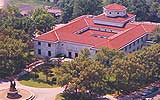Faculty
Josh Ellenbogen
In the 1880s, three photographic investigators used their medium to address problems in physiology, criminology, and anthropology. In the process, they helped transform what it meant to make a valid photograph, according to the book Ellenbogen is preparing, Photography and the Imperceptible: Bertillon, Galton, Marey.
Etienne-Jules Marey sought to analyze the body’s motions and its use of energy, partly in order to better train French soldiery. He affixed white lines to black-clad models - creating “homme squelettes,” or skeleton men - and photographed them repeatedly in motion, transforming movement into a series of luminous curves. His images sparked debate over whether contrived visualizations - ones without originals in perception that they could match or resemble - possessed either scientific validity or artistic relevance. The Italian Futurists, among others, embraced his vision of movement, and Marey partly laid doubts to rest by splicing together his images in proto-cinematic devices that contributed to the subsequent creation of film.
Criminologist Alphonse Bertillon sought to enforce France’s penalties for repeat offenders by storing bodily measurements and photographs of a million Paris-area criminals. He seized upon the profile as the perfect angle for the mug shot, because he thought it had only the most slender presence in perception. His profiles jibed with the avant-garde’s disenchantment with the classical notion of portraiture as an effort to capture all possible views of the subject in one image.
Francis Galton also complicated the relation of photography to what we see, in that he sought to make photos not of any visual object, but instead of concepts, the “types” of people prone to, say, criminality or ill health. He merged many photos of individuals fitting such descriptions, creating composites that he viewed as visualizations of mathematical equations. Galton believed artists were natural creators of composites, and that their work validated his.
“What they’re all doing is offering a different understanding of how photography is going to provide meaningful data,” says Ellenbogen.
Suddenly photography was more than a means of reproducing what the human eye saw. “This is a development that I take to be of epochal significance to the history of photography,” Ellenbogen says. “The kinds of deployments that these three made of the technology in the 1880's opened up new questions about the relationship of photography to visual perception. They also posed the question: Was art to reproduce what the eye sees, or what the camera reveals?"
A student of art history and the philosophy of science, Ellenbogen has studied Peruvian encyclopedias of images from the 1700s, representational theory as it relates to idolatry, and late-19th century photographers of the American West. That last topic is a subject of a museum exhibition he’s co-curating with Joel Snyder at the University of Chicago.
